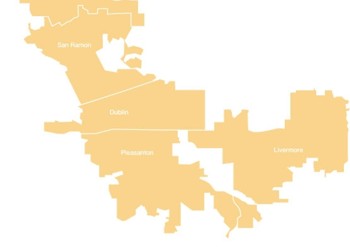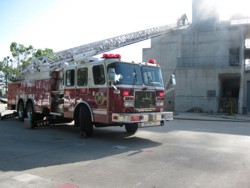Livermore-Pleasanton Fire Department Makes Plans for Disasters
Livermore-Pleasanton Fire Department Makes Plans for Disasters


Most Bay Area residents know that every passing year brings us ever closer to the prospect of a major earthquake. As a recent issue of the City of Pleasanton newsletter noted, "The United States Geological Survey (USGS) reports that the probability of California experiencing one or more earthquakes with a 6.7 magnitude or larger over the next 30 years is greater than 99 percent. USGS studies provide mounting evidence that the San Francisco Bay Area should prepare for another big quake soon. Two and a half million people now live along the Hayward Fault, and 7 million people in the region would feel a repeat event of the same magnitude."
While the topic is obviously uncomfortable, it should hardly be unmentionable. In fact, in light of the multitude of potential threats besides earthquakes - from fire to pandemic disease to terrorist attack-the issue of preparedness deserves more attention than ever. As Genevieve Pastor-Cohen, Emergency Preparedness Manager for the Livermore-Pleasanton Fire Department (LPFD), observes, "By being prepared when disaster hits, we can face it with knowledge, not fear."
To that end, in January the City of Pleasanton convened a local Disaster Council to build emergency planning and preparedness partnerships among public agencies as well as representatives from the private sector, such as Hacienda Business Park and Stoneridge Mall. Other Disaster Council participants include Pleasanton Unified School District, Alameda County, American Red Cross, ValleyCare Hospital, Zone 7 Water District, Livermore Amador Valley Transportation Authority, Axis Health Care, Valley Humane Society, Dublin-San Ramon Services District, Citizen Corps Volunteers, and others.
Such a broad-based team provides a big-picture view of both community vulnerabilities and resources, essential components of an effective disaster plan. "We are undergoing a comprehensive planning process with our partners," remarks Pastor-Cohen, adding, "Part of emergency management is taking a close look at the worst-case scenario. If you do anything less than that, you will not be ready."
The liaison among participants has proved invaluable in helping to come up with potential disaster responses, which, Pastor-Cohen emphasizes, are still a work in progress. "We have only been meeting for six months, and we're still in the discovery phase."
Business Continuity
One of the council's goals is an assessment of "who can supply what locally." Hacienda's sheer physical size, along with its infrastructure, could be instrumental in recovery on several fronts, she notes. "There is a lot of space out there that could potentially help us by providing a staging area if we have to bring resources in from the outside. The Fairgrounds are a natural focal point, but if they are already being utilized, we will need a back-up area for equipment." It is equally important to assess tenants' and residents' status post-disaster. In conjunction with Pastor-Cohen, Hacienda is looking at how to create a communications structure, a kind of emergency operations center, within the park that will enable park staff to collect condition reports from tenants and funnel that information to the city. "That way we will know where people are, what stage they are in, and what kind of resource needs they will have from the city so we can prioritize the most critical," Pastor-Cohen says.
The City's highest priority in a disaster, of course, is "anything life-threatening, regardless of whether it's on public or private property," she continues. The water supply falls into this category, and Pastor-Cohen is quick to deliver an oft-repeated caveat : "If a water main ruptures, the facility will have no water. Our message is to make sure employees have a three-day supply to sustain themselves in the workplace, and a 10 to 14-day supply at home. This will tide them over until water can be shipped into a neighborhood."
The second priority is property damage, another situation that potentially endangers building occupants. In the business park, a non-functioning facility also means the company is not able to conduct business, putting its lifeblood at risk as well. To ensure business continuity, Pastor-Cohen urges companies, large and small alike, to carefully explore what they will need to sustain their operations, be it back-up suppliers for critical materials used in manufacturing or back-up systems for their IT networks. She asks both home and work computer users: "Is your system mirrored offsite, so if disaster hits, you can reinstall all your data?"
Learning from Past Experience
The Disaster Council has made a special effort to focus on a few areas that surfaced as significant problems in the wake of previous disasters. One of these is the category of "access and functional needs," people who need assistance with activities of daily living because of diminished physically abilities. Pastor-Cohen cites a lesson learned by the state department of public health during the southern California fires. "There were two nursing homes that had to evacuate their residents. One group was directed to a hospital, and the other to a school. Those sent to the school survived well. There were classrooms where they could be separated according to need, and caretakers could conveniently come in and help. But at the hospital, because the people didn't quite fit into the life-threatening framework, they were moved around a lot, and there was about a 10 percent death rate. We are paying attention to this finding."
Providing care for household pets is a legacy from Katrina. Pastor-Cohen is in the process of helping the county develop an animal disaster plan. "Shelters for people often cannot accommodate pets, but it is possible to have nearby locations that can take them so they are not ripped from their owners. It is taking a lot of coordination, with planning discussions occurring countywide and within our community, including Valley Humane Society and local veterinarians, because we know how much animals mean to families."
Practice Makes Perfect
To make sure they remain effective, emergency plans need to be tested from time to time. Two significant preparedness events are slated for the month of October.
Public participation is encouraged in the Great ShakeOut earthquake preparedness drill, to be held this year on Thursday, October 21, at precisely 10:21 am. The countdown is on, with 5.2 million Californians already registered statewide.
Businesses, organizations, and community groups of all sizes can conduct such drills on their own premises at the appointed hour, so they can become familiar with and practice the best ways to protect themselves during an earthquake. This year, a new recommendation, "Secure Your Space," has been added to the standard "Drop, Cover, and Hold On" advice, urging home and business owners to secure building contents, especially heavy or fragile items, that could pose a threat in a quake. "By doing nothing about your home or belongings before an earthquake, it resigns you to become a disaster victim, no longer in control," observes the Earthquake Country Alliance at www.shakeout.org, the informative site where drills can be registered. Members of Pleasanton's Disaster Council will be participating in the ShakeOut as a group and will, for the first time, "test lines of communication to make sure all protocols are in place," says Pastor-Cohen.
The other practice run is the Bay Area-wide Urban Shield 2010, a mass casualty exercise for first-responders. Critical incidents related to homeland security will be staged in a variety of venues from October 15 through 18. "These exercises provide opportunities to enhance response efforts and identify training needs in a simulated environment," according to the web site www.urbanshield.org. The LPFD is one of the many supporting agencies for this preparedness event.
Pastor-Cohen has also revived Pleasanton's Community Emergency Response Team program, or CERT, which offers hands-on training in disaster first aid, basic fire fighting, disaster preparedness, damage assessment, utility control, light search and rescue operations, and team emergency organization. The six-week long course, which now includes a mass casualty exercise as part of its final drill, has proven quite popular, and registration for the next session, beginning in October, has already reached capacity. However, businesses can request on-site CERT training for groups of 25 or more.
As far-reaching as these governmental measures may be, individuals still play a big role in their own safety and survival in any type of disaster. "Our message to citizens is this: In the City of Pleasanton we have five fire stations, and about 18 firefighters available at any given time," Pastor-Cohen points out. When a catastrophe occurs, how far can we stretch those 18? That is why we participate in events like the First Wednesday street parties, the Farmers Market, and company safety fairs, reminding people how vital it is to have personal emergency supply kits - for three days in the car and 10 to 14 days at home. We know that grocery stores will be closed, ATMs will not work, transportation will be challenging. By doing all this preparation, at least you will have the basics you need," she concludes.
For more information about CERT classes and other preparedness details, contact the Emergency Preparedness Manager at GPastor-Cohen@lpfire.org.
Resources
A good source of home preparedness information is the LPFD's 34-page Family Disaster Preparedness Guide at www.ci.pleasanton.ca.us/pdf/livfamdis00.pdf. "Four Steps To Prepare For A Disaster" are described at www.ci.pleasanton.ca.us/services/fire/prepare-disaster.html. Links to additional advice and checklists are available from www.ci.pleasanton.ca.us/services/fire/emergency-preparedness.html.
Pleasanton's 2005 Emergency Management Plan is a comprehensive document outlining the city's responsibilities in the event of natural disaster, human-caused emergencies, and technological incidents. It provides a framework for coordinated response and recovery efforts with local, state, and federal agencies and establishes an organization to direct and control operations by assigning responsibilities to specific employees. It can be viewed at www.ci.pleasanton.ca.us/pdf/eoc-basic-plan-05.pdf.
Other planning aids are FEMA's Emergency Management Guide for Business & Industry, at www.fema.gov/business/guide/index.shtm; and the American Red Cross's Business & Industry Guide: Preparing Your Business for the Unthinkable at www.redcross.org/www-files/Documents/pdf/Preparedness/PrepYourBusfortheUnthinkable.pdf.
Hacienda has produced a custom Emergency Procedures Manual for download at www.hacienda.org/forms/forms_materials_security.html.
For Further Information
The LPFD Public Safety Information Hotline at (925) 454-2375 offers pre-recorded contact information for disaster preparedness presentations and CPR, first aid, and CERT emergency training. The department also offers inspections to make sure businesses, apartments, etc., are fire safe. These can be arranged by calling (925) 454-2361. Pastor-Cohen can also be reached through that number.
Local Emergency Response
Emergency 911 services from the LPFD Operations division include:
-
Fire Suppression for fires in buildings of all types, car fires, grass or rubbish fires, etc.
-
Emergency Medical Response with personnel trained as Firefighters/Paramedics and Emergency Medical Technicians who can provide Advanced Life Support (ALS) as well as Basic Life Support (BLS).
-
Rescue Operations for people trapped in wrecked cars, collapsed buildings, machinery, etc.
-
Hazardous Materials Incidents where a materials release represents a threat to life, property, or the environment. This includes natural gas leaks.
-
Public Assistance for situations involving children locked in cars or homes, disabled persons needing help, etc.
Also in this issue...
- Trapeze Networks Takes Enterprise-Class Wi-Fi to New Levels
- Arrival of Precision System Science USA Adds to Hacienda Biotech Population
- Business Bits
- Executive Profile: Sherman Balch, Extollo International
- Resounding Success Equips IronPlanet for IPO
- Customized Attention is Hallmark of Huntington Learning Center
- Livermore-Pleasanton Fire Department Makes Plans for Disaster
- LAVTA Service Improvements: Hold That Green and Real-Time Arrival Messages
- Mark Your Calendars: Pleasanton Green Scene Fair Set for October 21
- "Shop Around Pleasanton" Holiday Campaign Uses Facebook to Generate Buzz
- Hacienda Index
- Calendar




